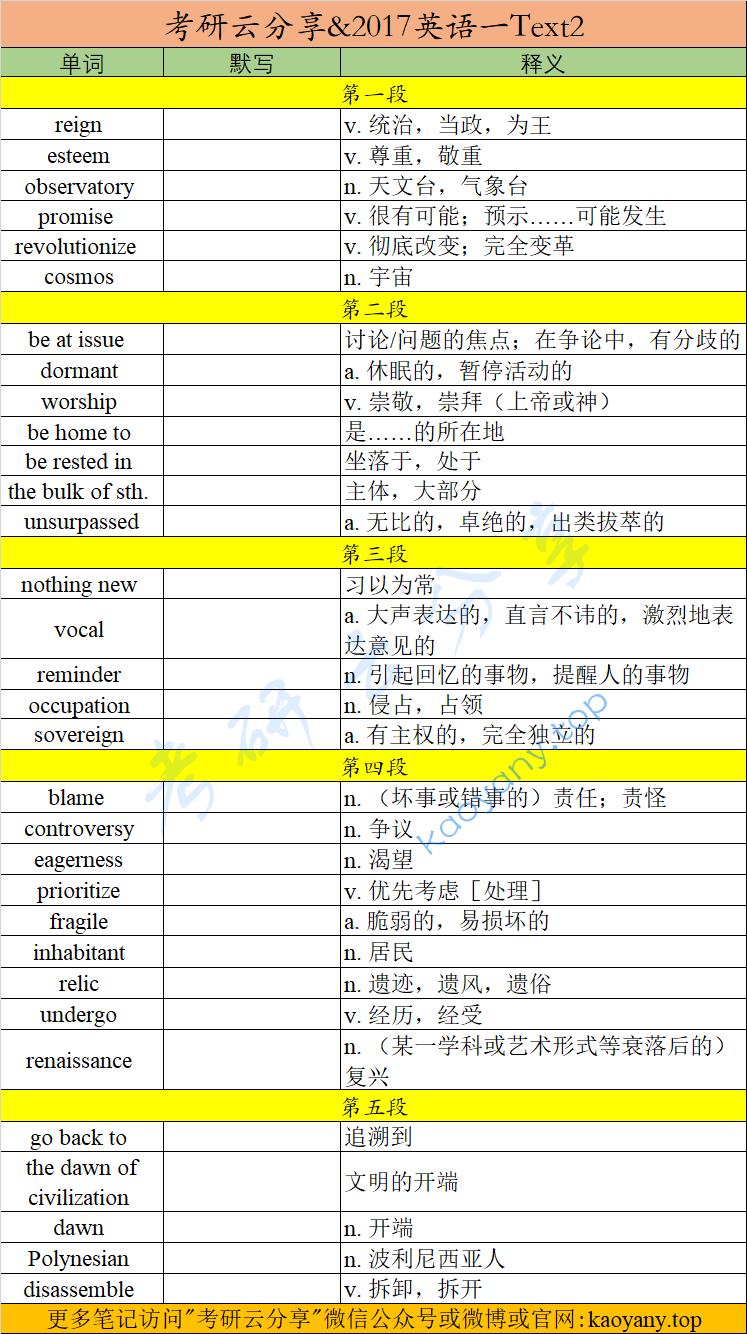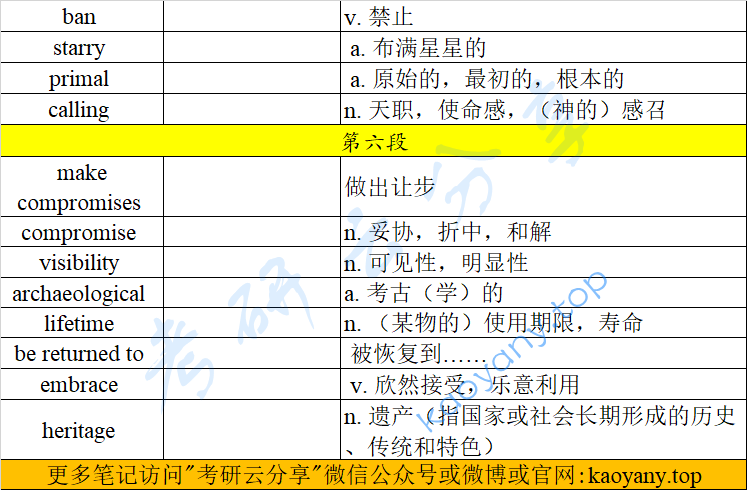第一段
“The ancient Hawaiians were astronomers,” wrote Queen Liliuokalani, Hawaii’s last reigning monarch, in 1897. Star watchers were among the most esteemed members of Hawaiian society. Sadly, all is not well with astronomy in Hawaii today. Protests have erupted over construction of the Thirty Meter Telescope(TMT), a giant observatory that promises to revolutionize humanity’s view of the cosmos.
单词&词组
reign v. 统治,当政,为王
esteem v. 尊重,敬重
observatory n. 天文台,气象台
promise v. 很有可能;预示……可能发生
revolutionize v. 彻底改变;完全变革
cosmos n. 宇宙
本段翻译
“古代夏威夷人是天文学家,”1897年,夏威夷最后一位君主丽约奥卡拉尼王后写道。观星者是夏威夷社会最受尊敬的成员之一。可悲的是,今天夏威夷的天文学并不尽如人意。30米望远镜(TMT)的建造引发了抗议,这是一个承诺将彻底改变人类对宇宙的看法的巨型天文台。
第二段
At issue is the TMT’s planned location on Mauna Kea, a dormant volcano worshiped by some Hawaiians as the piko that connects the Hawaiian Islands to the heavens. But Mauna Kea is also home to some of the world’s most powerful telescopes. Rested in the Pacific Ocean, Mauna Kea’s peak rises above the bulk of our planet’s dense atmosphere, where conditions allow telescopes to obtain images of unsurpassed clarity.
单词&词组
be at issue 讨论/问题的焦点;在争论中,有分歧的
dormant a. 休眠的,暂停活动的
worship v. 崇敬,崇拜(上帝或神)
be home to 是……的所在地
be rested in 坐落于,处于
the bulk of sth. 主体,大部分
unsurpassed a. 无比的,卓绝的,出类拔萃的
本段翻译
争论的焦点是TMT计划在毛纳凯亚(Mauna Kea)的位置,这是一座休眠火山,一些夏威夷人将其视为连接夏威夷群岛和天空的piko。但毛纳凯亚也是世界上最强大的望远镜的所在地。坐落在太平洋上的莫纳克亚峰位于地球上大部分稠密的大气层之上,那里的条件允许望远镜获得无与伦比的清晰图像。
第三段
Opposition to telescopes on Mauna Kea is nothing new. A small but vocal group of Hawaiians and environments have long viewed their presence as disrespect for sacred land and a painful reminder of the occupation of what was once a sovereign nation.
单词&词组
nothing new 习以为常
vocal a. 大声表达的,直言不讳的,激烈地表达意见的
reminder n. 引起回忆的事物,提醒人的事物
occupation n. 侵占,占领
sovereign a. 有主权的,完全独立的
本段翻译
反对在莫纳克亚使用望远镜并不是什么新鲜事。一小部分夏威夷人和环境一直认为他们的存在是对圣地的不尊重,是对曾经是主权国家的占领的痛苦提醒。
第四段
Some blame for the current controversy belongs to astronomers. In their eagerness to build bigger telescopes, they forgot that science is the only way of understanding the world. They did not always prioritize the protection of Mauna Kea’s fragile ecosystems or its holiness to the island’s inhabitants. Hawaiian culture is not a relic of the past; it is a living culture undergoing a renaissance today.
单词&词组
blame n. (坏事或错事的)责任;责怪
controversy n. 争议
eagerness n. 渴望
prioritize v. 优先考虑[处理]
fragile a. 脆弱的,易损坏的
inhabitant n. 居民
relic n. 遗迹,遗风,遗俗
undergo v. 经历,经受
renaissance n. (某一学科或艺术形式等衰落后的)复兴
本段翻译
目前的争议有一些归咎于天文学家。他们急于建造更大的望远镜,却忘了科学是了解世界的唯一途径。他们并不总是把保护毛纳凯亚脆弱的生态系统或它对岛上居民的神圣性放在优先地位。夏威夷文化不是过去的遗迹;它是一种活生生的文化,今天正在经历复兴。
第五段
Yet science has a cultural history, too, with roots going back to the dawn of civilization. The same curiosity to find what lies beyond the horizon that first brought early Polynesians to Hawaii’s shores inspires astronomers today to explore the heavens. Calls to disassemble all telescopes on Mauna Kea or to ban future development there ignore the reality that astronomy and Hawaiian culture both seek to answer big questions about who we are, where we come from and where we are going. Perhaps that is why we explore the starry skies, as if answering a primal calling to know ourselves and our true ancestral homes.
单词&词组
go back to 追溯到
the dawn of civilization 文明的开端
dawn n. 开端
Polynesian n. 波利尼西亚人
disassemble v. 拆卸,拆开
ban v. 禁止
starry a. 布满星星的
primal a. 原始的,最初的,根本的
calling n. 天职,使命感,(神的)感召
本段翻译
然而,科学也有其文化史,其根源可以追溯到文明的黎明。早期波利尼西亚人第一次来到夏威夷海岸时,人们对寻找地平线以外的东西的好奇心同样激励着今天的天文学家探索天空。要求拆除莫纳凯亚所有望远镜或禁止在那里进行未来开发的呼吁忽视了这样一个现实:天文学和夏威夷文化都试图回答关于我们是谁、我们来自哪里和我们要去哪里的大问题。也许这就是我们探索星空的原因,仿佛在回应一个原始的召唤,去了解我们自己和我们真正的祖先家园。
第六段
The astronomy community is making compromises to change its use of Mauna Kea. The TMT site was chosen to minimize the telescope’s visibility around the island and to avoid archaeological and environmental impact. To limit the number of telescopes on Mauna Kea, old ones will be removed at the end of their lifetimes and their sites returned to a natural state. There is no reason why everyone cannot be welcomed on Mauna Kea to embrace their cultural heritage and to study the stars.
单词&词组
make compromises 做出让步
compromise n. 妥协,折中,和解
visibility n. 可见性,明显性
archaeological a. 考古(学)的
lifetime n. (某物的)使用期限,寿命
be returned to 被恢复到……
embrace v. 欣然接受,乐意利用
heritage n. 遗产(指国家或社会长期形成的历史、传统和特色)
本段翻译
天文学界正在作出妥协,以改变其对毛纳凯亚的使用。选择TMT地点是为了尽量减少望远镜在岛上的能见度,避免考古和环境影响。为了限制莫纳克亚山上望远镜的数量,旧的望远镜将在寿命结束时被拆除,其所在地恢复自然状态。没有理由不欢迎毛纳克亚的每一个人接受他们的文化遗产和研究星星。
五道题
26. Queen Liliuokalani’s remark in Paragraph 1 indicates___.
[A] its conservative view on the historical role of astronomy.
[B] the importance of astronomy in ancient Hawaiian society.
[C] the regrettable decline of astronomy in ancient times.
[D] her appreciation of star watchers’ feats in her time.
27. Mauna Kea is deemed as an ideal astronomical site due to
[A] its geographical features
[B] its protective surroundings.
[C] its religious implications.
[D] its existing infrastructure.
28. The construction of the TMT is opposed by some locals partly because___.
[A] it may risk ruining their intellectual life.
[B] it reminds them of a humiliating history.
[C] their culture will lose a chance of revival.
[D] they fear losing control of Mauna Kea.
29. It can be inferred from Paragraph 5 that progress in today’s astronomy___.
[A] is fulfilling the dreams of ancient Hawaiians.
[B] helps spread Hawaiian culture across the world.
[C] may uncover the origin of Hawaiian culture.
[D] will eventually soften Hawaiians’ hostility.
30. The author’s attitude toward choosing Mauna Kea as the TMT site is one of___.
[A] severe criticism.
[B] passive acceptance.
[C] slight hesitancy.
[D] full approval.
参考答案
BABAD
答案解析
26、由题干中的Queen Liluokalani's remark和Paragraph1定位到第一段第一句。定位句引用利留卡拉尼女王的话"古代夏威夷人都是天文学家"。第二句接着指出,在夏威夷社会,观星师们曾经有着崇高的地位。由此可推断出,女王的话语说明了天文学在古代夏威夷社会中的重要性,由此可确定本题答案为[B]。
27、由题干中的Mauna Kea和site定位到第二段第三句。本段首先引出TMT的计划修建地点——莫纳克亚山。接着第三句点明选址原因:莫纳克亚山高耸于地球大部分密集大气层,这使得望远镜能够获得清晰度无与伦比的图像。也就是说,它独特的地理特征使它成为理想的天文台选址,故[A]为本题答案。
28、由题干中的opposed和some locals定位到第三段。定位段指出,一群规模不大但呼声很高的夏威夷人和环境保护主义者长期以来一直认为这些望远镜的存在是对圣地的亵渎,是一个心痛的提醒,提醒着其曾经的主权国家已被占领。由此可推断出,望远镜的存在让他们想起耻辱的历史,故答案为[B]。
29、由题干定位到第五段。该段阐明了科学与文化的关系。由定位段可知,古代波利尼西亚人带着好奇心探索世界,才发现了夏威夷;今天,科学家们探索星空,也是因为同样的好奇心驱使;不管是夏威夷文化,还是现在的天文科学,都在试图回答那些困扰人类的哲学问题,从而去回应原始的呼唤,了解自身和祖先的真正家园。由此可推断出,天文学的发展有可能会实现古代夏威夷人的梦想,故本题答案为[A]。
30、文章开篇就通过女王的话说明在古代夏威夷社会中,天文学的地位是极为崇高的。在第五段中,作者分析了夏威夷文化和天文学的共通之处,说明两者应该共存,共同发展。在文章最后,作者指出没有理由不欢迎人们去莫纳克亚山拥抱他们的文化遗产并研究星体。由以上信息可以判断,作者对于在莫纳克亚山建造天文望远镜持完全赞成的态度,没有任何犹豫,故本题答案为[D]。


- 单词 词组
- 本段翻译
- 单词 词组
- 本段翻译
- 单词 词组
- 本段翻译
- 单词 词组
- 本段翻译
- 单词 词组
- 本段翻译
- 单词 词组
- 本段翻译
- 参考答案
- 答案解析
